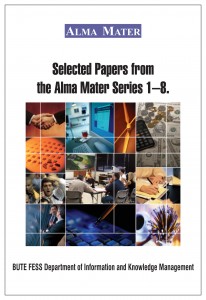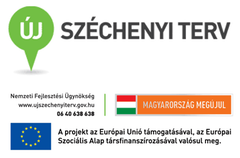
Cím:
Selected papers from the Alma Mater Series 1-8.
Kiadó:
BME GTK ITM
Kiadás éve:
2004. szeptember
Oldalak száma:
205-
- Cím:
- Universal intelligent demon structure with various knowledge bases for optimum determination
- Írta:
- Dr. Gábor Szűcs
- Oldalak száma:
- 1-18
- In recent years simulation methodology for intelligent demon controlled simulation experimentation has been developed [1]. The theoretical results of the investigations have been implemented in the CASSANDRA (Cognizant Adaptive Simulation System for Applications in Numerous Different Relevant Areas) simulation system [2]. This system is based on a very high level, so called Knowledge Attributed Petri Nets (KAPN). The approach has been tested in various fields of applications, among them international projects (EUREKA, COPERNICUS) of the European Union [6][4]. The aim was to reduce the tedious and lengthy iterative process of model building, dynamic simulation, evaluation of the results, model reconstruction by monitoring the simulation experiments with intelligent demons having knowledge bases, inference engines and modules performing actions on the models. These demon objects are able to collect information about the trajectory of the dynamic simulation and after having evaluated it, may change model structure and/or parameters to obtain the required optimal solution. Thereby the whole procedure that may be described as simulation in the large [5] could be made highly efficient. Keywords: simulation, AI controlled optimum determination; Inference engine; Intelligent demons; Knowledge bases
-
- Cím:
- India’s Pioneer Taking on the World
- Írta:
- Tuan M. Pham
- Oldalak száma:
- 19-33
- –
-
- Cím:
- Online Stores
- Írta:
- Gergely Babos
- Oldalak száma:
- 35-39
- Have you ever tried to buy anything on Internet, maybe via electronic payment? Probably not… Most of us are afraid of using Internet Banking, sites, where our real personal data is required, especially where some electronic payment occurs. On the one hand there are some safety and security issues, people must be convinced and they have to be sure, that their transactions are handled on the right way, on the other hand there is the product. How can be sure, that the product is really in the warehouse, the supplier registers the order and it will be delivered? In the following article I introduce the basic functional background of the Online Stores.
-
- Cím:
- Differences between ASP (Application Service Provider) and CSP (Commerce Service Provider)
- Írta:
- Gergely Babos
- Oldalak száma:
- 41-48
- Abbreviations are passing by, some of them have several meanings, and others are unique and completely clear. In “e-world” there are two more and more commonly used terms, ASP (Application Service Provider) and CSP (Commerce Service Provider). As solutions and possibilities became wider, number and character of e-providers had increased. Recently content providers were sharing in ASP and CSP titles and functions – some cases not using the correct terminology. Nowadays not only content providers, but also solution, business and different kinds of service providers appear on Internet. I this study I will try to give a clear definition and global overview about differences and similarities between ASP and CSP. I will highlight particular areas, where different providers are of high importance.
-
- Cím:
- Outsourcing Payment Card Services In Vietnam: An Opportunity and How to Capture It
- Írta:
- Tuan M. Pham
- Oldalak száma:
- 49-70
- Outsourcing of technology-heavy activities is an emerging trend in many industries, particularly in the banking sector. With certain advantages and disadvantages in each individual bank’s case, outsourcing is not necessarily beneficial for all banks. However, in many cases, banks which would greatly benefit from outsourcing are still resisting it, due to various non-economic reasons. This is especially puzzling in more developed countries where outsourcing as a concept has had more time to prove itself. The United States, Hungary, and Vietnam are some sample countries around the world whose banking industries represent substantially different stages of development. Even in Vietnam’s less developed banking sector, institutions are recognizing the benefits of outsourcing, particularly in payment cards processing. This fact might serve as a lesson for “resisting” banks in more developed countries, in order to more objectively consider the economic arguments behind the concept of outsourcing. At the beginning of 2003, there is a window of opportunity for the Vietnamese banking sector to create a Independent Service Organization (ISO) for Payment Cards. Not only the analysis of the current situation, but also examples of other economies – whose banking sectors has evolved through various transitional periods – suggest that it would be a win-win for everyone if an ISO provided transaction processing and end-device (ATM and POS) deployment services instead of individual banks performing those activities themselves. The ISO would help the financial services sector avoid wasting of resources due to overlapping investments, allow the participating banks to dramatically reduce their time-to-market in introducing card services, create more convenience and clarity for consumers, and also generate attractive returns for its investors as a profitable business. This paper analyses the current situation of Vietnam’s banking industry, makes a recommendation on how banks can cooperate in outsourcing payment cards services by establishing an ISO, and gives an overview on how banks are currently reacting to this trend.
-
- Cím:
- Quality Assurance in Financial Institutions
- Írta:
- Kristóf Szabó
- Oldalak száma:
- 71-80
- The passage quoted reads as follows: “Costly the habit as thy purse can buy”, it was said by Polonaise to his son, Laertes, in Shakespeare’s drama. The figurative sense of this saying can be applied even nowadays when thinking about quality assurance. The meaning of Quality as service concept gives the relationship between the saying and quality assurance. During the process our aim is not to raise the level of service permanently, but to guarantee the quality of service, composed by the institution concerning cost benefit (especially in market economical circumstances).
-
- Cím:
- Universal software architectures for registry, report creator and workflow administrator application
- Írta:
- Miklós Vázsonyi
- Oldalak száma:
- 81-93
- Registry, report creator and workflow administrator applications can be built in a simply way by using a reflexive database and software architecture which features dinamic window generation, report wizard and has a univesral workflow engine. Using this software architecture we can easily implement several specific enterprise information systems. Every parameters of the applications are given in data tables that is why the layout of the application can be easily modified without any programming knowledge. It means that the application provides parameters for the objects in run-time. To implement a specific system based on these core systems there is no need to use any development environment by using this reflexive application.
-
- Cím:
- Internationalization of a Russian Vodka and Liquor Company (Part 1)
- Írta:
- Tamás Joó – Natasha Ivanova
- Oldalak száma:
- 95-110
- How can a Russian Vodka and Liquor Company penetrate into the Danish market? To analyze this problem we will make a market research and conclude with an action plan to full fill the needs of the Orenburg Distillery Ltd. This Russian company, located in the city of Orenburg, has brought up the subject, to analyze their international market chances. Denmark and the Danish market seemed to be a good target market for this project because it is known from statistics (www.dst.dk) that alcohol is a part of the Danish culture. There are quite a few different brands already established in the Danish market but we found out that the Danish taste is changing and that especially the younger generation is asking for different kinds and brands of Vodka. This is the group that will also adopt a new product faster and is more open to new trends. The main part of this project is the section on the Danish distribution system and how we can establish our brand over the following years next to the big competitors. This is still a rather small company we are talking about with limited resources and not much experience.
-
- Cím:
- Internationalization of a Russian Vodka and Liquor Company (Part 2)
- Írta:
- Tamás Joó — Natasha Ivanova
- Oldalak száma:
- 111-134
- –
-
- Cím:
- Two Decades of Supporting Procurement Decision Making: Past, Present and Future
- Írta:
- Péter Gelléri — Csaba Csáki
- Oldalak száma:
- 135-155
- Working in the application area of procurement as decision consultants for almost two decades using the same feature–rich GDSS tool we have developed provides us with the opportunity to conclude a few lessons and investigate possibilities. This paper presents the experiences about the features used and takes a peek behind the seen why they did or did not meet the same success. We propose additional capabilities asked for either by end–users or by the consultant and we also examine the chances of introducing new features.
-
- Cím:
- Simple Implementation of the SPCA Input Feature Extraction Method in Matlab
- Írta:
- Péter Wittek
- Oldalak száma:
- 157-162
- –
-
- Cím:
- Corporates Security
- Írta:
- György Vasvári
- Oldalak száma:
- 163-170
- –
-
- Cím:
- The magic cube of e-business
- Írta:
- Petra Boros — Balázs Szekfű
- Oldalak száma:
- 171-183
- The focus of this study is to provide a new approach and interpretation of e-business as a science, in order to endorse a new starter e-business faculty at the Budapest University of Technology and Economics During the planning of the faculty we have analyzed numerous e-business definitions and approaches. We have found numberless concept, which approach the issue solely by the aspect of the business model and the strategy of a company (for example: www.digitalenterprise.org) or the applied technology (PricewaterHouseCoopers, Oracle IBM, etc.). In contrast Robinson and Kalakota have stated that “e-Business is the complex fusion of business processes, enterprise applications, and organizational structure necessary to create a high-performance business model.” There are other views, which merely extend the e-commerce category by expressions like serving the consumers and cooperation with partners. Furthermore, plenty of studies deal with the different branches of e-business like e.g. e-government, knowledge management, e-procurement, etc. We think that these approaches are certainly appropriate in a way, although don’t aim to provide an overall picture of the e-business. Our new “magic cube” concept strives to place this field in a context, which reveals the relations of the topic in an interdisciplinary way. Moreover, our study also proceeds from that basic assumption that e-business is present or will be present in every type of organization and industry as at least a supporting and secondary activity, and not rarely as an engine of the core activity. In our short study we try to place the issue in a framework, which is easy to be understood, to be identified for everyone and at the same time is expandable flexibly according to the demanding changes of the world.
-
- Cím:
- SME Prospects in the EU
- Írta:
- Gergely Babos
- Oldalak száma:
- 185-192
- The facts are as follows: 19 million enterprises employ around 115 million employees in 19 European countries (beside the EU member states included also the states of the European economic area and Switzerland). The majority of them – 99.8% – belong to SME (Small and Medium Sized Enterprises) category. The generality, 18 million enterprises employ less, then 10 employees and the half of them are self-employed. A main goal (so called priority) of the European Union is the support of SMEs, expansion of their development possibilities. It is a fundamental condition of regions’ alignment and improvement of economic competitiveness and life quality, that the European Union ensures appropriate possibilities and support to this sector. This is the reason, why it is important to take into consideration what are the main support channels of SMEs in Hungary: • the operative programs of the National Development Plan (NFT) from 2004 until 2006; • so called pre-accession funds available until the accession (PHARE, SAPARD, ISPA); • tenders of the Ministry of Economy and Transport for enterprise, tourism and energy-efficiency development; • tender possibilities of other local ministries and organizations from local financing; • public programs of the European Union available until and after the accession (Life, EU 6FP, Enterprise and SMEs, Program for Intelligent Europe). This elaboration intends to highlight the significance of SME sector and mark the main changes that will take place in the coming few years.
-
- Cím:
- TCP/IP protocol anonymization on local area networks
- Írta:
- László Kéri
- Oldalak száma:
- 193-205
- There are a number of technologies ensuring the anonymity of Internet communications already, but despite the fact that local anonymity on Ethernet networks could be a widely used, important privacy enhancing technology, it’s potentials haven’t received much attention yet. In this article we’ll discuss the possibility of an implementation of local anonymity, which doesn’t require the introduction of new anonymous protocols in place of existing ones. It rather harnesses the possibilities of existing protocol implementations to achieve local sender (client) anonymity up to the IP layer through a method called protocol anonymization. The proposed method can be realized with most operating systems without interfering with the TCP/IP protocol stack or existing applications. Introduction The obscuring of the partners involved in a communication, the anonymization of network communications is one of the main research fields of existing privacy technologies. There are two well known principles of making a communication anonymous proposed by Chaum: the Mix and the superposed sending, the latter being based on the Dining Cryptographers problem. These principles are independent of the communication media, they are developed from a highly abstract model of communications, which consists of a message being passed from a sending party to a receiving party through some kind of communication channel, so these principles are capable of anonymizing any kind of communication. The technologies which are implementing the principles of anonymization are translating these principles in the context of the most important network, the Internet and since the Mix approach suits best the structure of the Internet, hence the technologies put into practice are almost every time Mix implementations. The anonymizing technologies developed with the Internet in mind as a medium are built upon the mesh of interconnected TCP/IP protocol based local networks. The Internet technologies implementing the Mix scheme (e.g. anonym remailers, Crowds, Onion routing) are making obscure the originator and recipient of the message needed for it’s delivery by the network infrastructure with the help of intermediaries, or in other words these technologies are expanding the possibility of the identities of the parties involved to an anonymity set in view of an attacker. But the addresses of identifiable network hosts are inevitably needed in the course of communications. Unlike Internet anonymity, local network anonymity has received little attention so far. The circumstances of local networks may create totally different conditions to the Internet from the perspective of anonymization, but the implementation of local anonymity still can be an important goal of privacy technologies. One reason is that if the local network is connected to the Internet local anonymity can supplement and even replace Internet anonymity to a certain degree, but supposing an isolated local network, achieving local anonymity within the borders of the local network can be desirable in it’s own rights. The proposed local anonymity scheme is after a solution for anonymity in respect of the characteristics of local networks and network protocols. Our solution for anonymity is not based on the usual approach, the introduction of new anonymous protocols, rather on turning existing protocols anonymous, that is on protocol anonymization, which is an important fact considering practical applicability.


